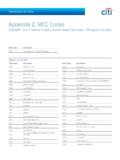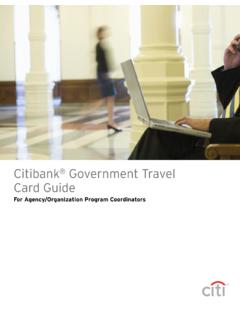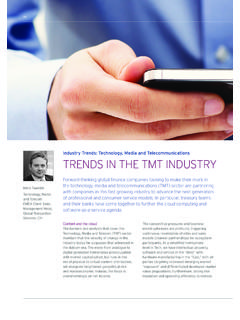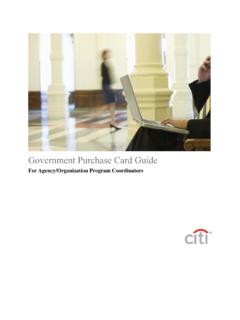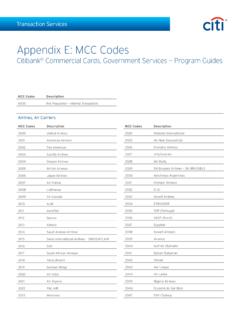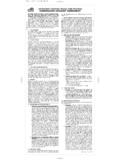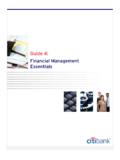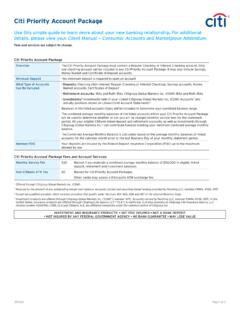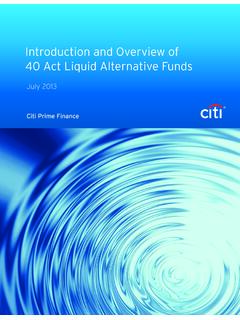Transcription of Environmental and Social Policy Framework - Citi
1 Environmental and Social Policy FrameworkMarch 20212 | Environmental AND Social Policy FRAMEWORKC ontents2025 Sustainable Progress Strategy Low-Carbon TransitionClimate Risk Sustainable OperationsOur CommitmentsPrinciples, Standards and Frameworks Climate Change Human Rights Environmental and Social Risk Management (ESRM)ESRM Policy Implementation Policy Prohibitions Areas of High Caution Sector Standards Supply Chain Engagement, Transparency and ReportingStakeholder Engagement Employee Engagement ReportingGovernance Appendix 34567 71011 121315161822 232323242426 Environmental AND Social Policy Framework | 32025 Sustainable Progress StrategyThe climate crisis is one of the most critical challenges facing our global society and economy in the 21st century. The data is irrefutable, and the world s climate scientists agree that urgent action must be taken to address the current and potential impacts of climate change, including chronic changes to temperature and precipitation, rising sea levels, and more intense and frequent extreme weather events.
2 Some of these impacts are already being felt in communities across the globe, and longer-term climatic changes have the potential to cause wide-ranging impacts affecting business and society, including disrupted supply chains, damaged infrastructure, reduced crop yields and a decline in biodiversity. These risks and impacts are exacerbated by inequality and unsustainable economic development, which put additional pressure on land, water, forests and other natural resources. These interconnected challenges endanger the vitality of communities all over the world and present a threat to global prosperity if not managed properly. The financial sector has an important role to play in addressing this crisis by supporting the transition to a sustainable, low-carbon economy that balances the Environmental , Social and economic needs of society.
3 citi understands these critical sustainability issues, and recognizes that we have an imperative to respect and support the environment and human rights in our operations, supply chain and client transactions. We also understand the complexity of developing solutions to these challenges, which require a combination of strong governmental Policy and regulatory frameworks, corporate leadership, investor engagement and individual actions. To continue advancing our response to these challenges, in 2020 we launched our new 2025 Sustainable Progress Strategy with the ambition to be the world s leading bank in driving the transition to a low-carbon economy. As one of the largest financiers of carbon-intensive sectors such as oil & gas, power and industrials, we know that this ambition to bring our business and the global economy into alignment with the Paris Agreement will not be easy.
4 It will require rapid and far-reaching transitions in energy systems, industrial processes, land-use, buildings, transport and other infrastructure. We also know that delaying this transition could significantly increase costs, lock in carbon-emitting technology and infrastructure, increase the amount of stranded assets and reduce the range of effective responses to the challenge in the medium and long term. As an important next step, we announced in March 2021 our intent to achieve net zero by 2050, including net zero in our own operations by 2030. We plan to publish our net zero plan by early 20+ year sustainability track record of working with clients, partners, employees and other key stakeholders to address the growing risks and opportunities related to climate has positioned us to respond to this challenge.
5 We have co-created sustainable finance and due diligence frameworks including the Equator Principles, the Green Bond Principles and the Poseidon Principles by bringing together financial institutions to develop best practices and drive sustainable change. Those experiences were training grounds for the collaborative innovation that is needed now. We know there is more to do and we will continue to learn, engage and report on our progress, but we cannot do it alone. We support responsible and interconnected governmental action on climate to align incentives across the economy to support a low-carbon future, including robust approaches to carbon pricing and disclosure of climate | Environmental AND Social Policy FRAMEWORKAs we start the Decade of Action to achieve the UN Sustainable Development Goals and Paris Agreement, our 2025 Sustainable Progress Strategy sets out three key pillars of activity that contribute to the world s sustainable development agenda: Recognizing the need for urgent action, we are setting out these ambitions over a five-year period to 2025.
6 In addition to annual progress reports, this midway point on the road to 2030 will offer an opportunity to reflect on our progress and adapt our plans for the future as needed. Low-Carbon TransitionCiti is committed to advancing solutions that address climate change around the world. We re building upon our long track record of sustainable finance commitments by establishing a new five-year $250 Billion Environmental Finance Goal to accelerate the transition to a low-carbon economy. The criteria for our goal expands on that of our previous goal resulting in $164 billion in Environmental finance from 2014 to 2019. We have included additional criteria on the circular economy and sustainable agriculture and land use and have incorporated elements of emerging frameworks, such as the EU Taxonomy.
7 Transactions that meet one or more of the goal s criteria will be counted using our league table methodology where applicable, and otherwise counting citi s direct TransitionAccelerate the transition to a low-carbon economy through our $250 Billion Environmental Finance GoalClimate RiskMeasure, manage and reduce the climate risk and impact of our client portfolioSustainable OperationsReduce the Environmental footprint of our facilities and strengthen our sustainability cultureENVIRONMENTAL AND Social Policy Framework | 5 citi will also continue to develop innovative financing structures and look for opportunities to scale positive impact in these and other areas. As the world s most global bank , we have the opportunity to support clients in all sectors through the low-carbon transition.
8 We recognize that companies are at different stages in their sustainability journey, but we also recognize the urgent need to transform all sectors of the economy to meet the challenges of climate RiskCiti is committed to managing climate risks and implementing the recommendations of the Financial Stability Board s Task Force on Climate-related Financial Disclosures (TCFD). Building on our Environmental and Social Risk Management (ESRM) Policy and our experience in climate risk analysis, we will further test the resilience of citi s lending portfolios to transition and physical risks related to climate change. We will also begin measuring the climate impact of our portfolios and their potential alignment with and 2oC warming scenarios. These analyses will help accelerate our understanding of the climate Goal CriteriaDescriptionCircular EconomySubstitution of virgin raw materials with recycled or recyclable materials, elimination and replacement of hazardous/toxic materials with sustainable or recyclable materials or recovery of materials from previously discarded products or projectsClean TechnologyProducts, equipment, methods and projects that mitigate greenhouse gas (GHG)
9 EmissionsEnergy EfficiencyResidential and commercial energy efficiency improvements that reduce energy consumptionGreen BuildingsConstruction or renovation of certified buildings for reduction or efficiency in energy use, resource consumption or for low GHG emissionsRenewable EnergyGeneration and/or storage of energy from renewable energy sourcesSustainable TransportationZero- and low-emissions vehicles, public transportation or related infrastructure construction and efficiency improvement Sustainable Agriculture and Land UseSustainable ecosystem management leading to carbon removal from the atmosphere, reduced emissions, improvement of soil fertility and conservation of natural resourcesWater Quality and ConservationImprovement of water quality, improved efficiency and increased availability and conservation of freshwater resourcesExclusionary Criteria Large scale hydropower plants that have a generation capacity of over 25MW Fossil fuel projects, including: Refined or alternative coal technologies Gas-to-liquid projects Natural gas projects6 | Environmental AND Social Policy Framework risks faced by citi and our clients and the possible pathways for our collective transition to a low-carbon economy.
10 We will explore opportunities to collaborate with our clients and peers to develop industry-wide methodologies for climate risk analysis and disclosure. Our approach to analyzing and reducing climate risk associated with our clients includes three areas of activity: Policy Development: Further integrate climate risk into citi s risk policies and governance frame-works; progressively and iteratively update our ESRM Policy and sector standards for carbon-intensivesectors to incorporate evolving best practice. Portfolio Analysis and Measurement: Utilize climate scenario analysis and stress testing of ourportfolios to understand the differentiated impacts (or resilience) our clients exhibit to transition orphysical climate risks; assess and test emerging methodologies to quantify the climate risks relatedto our clients activities, to estimate emissions associated with our portfolio, and to evaluate portfoliodecarbonization pathways.

